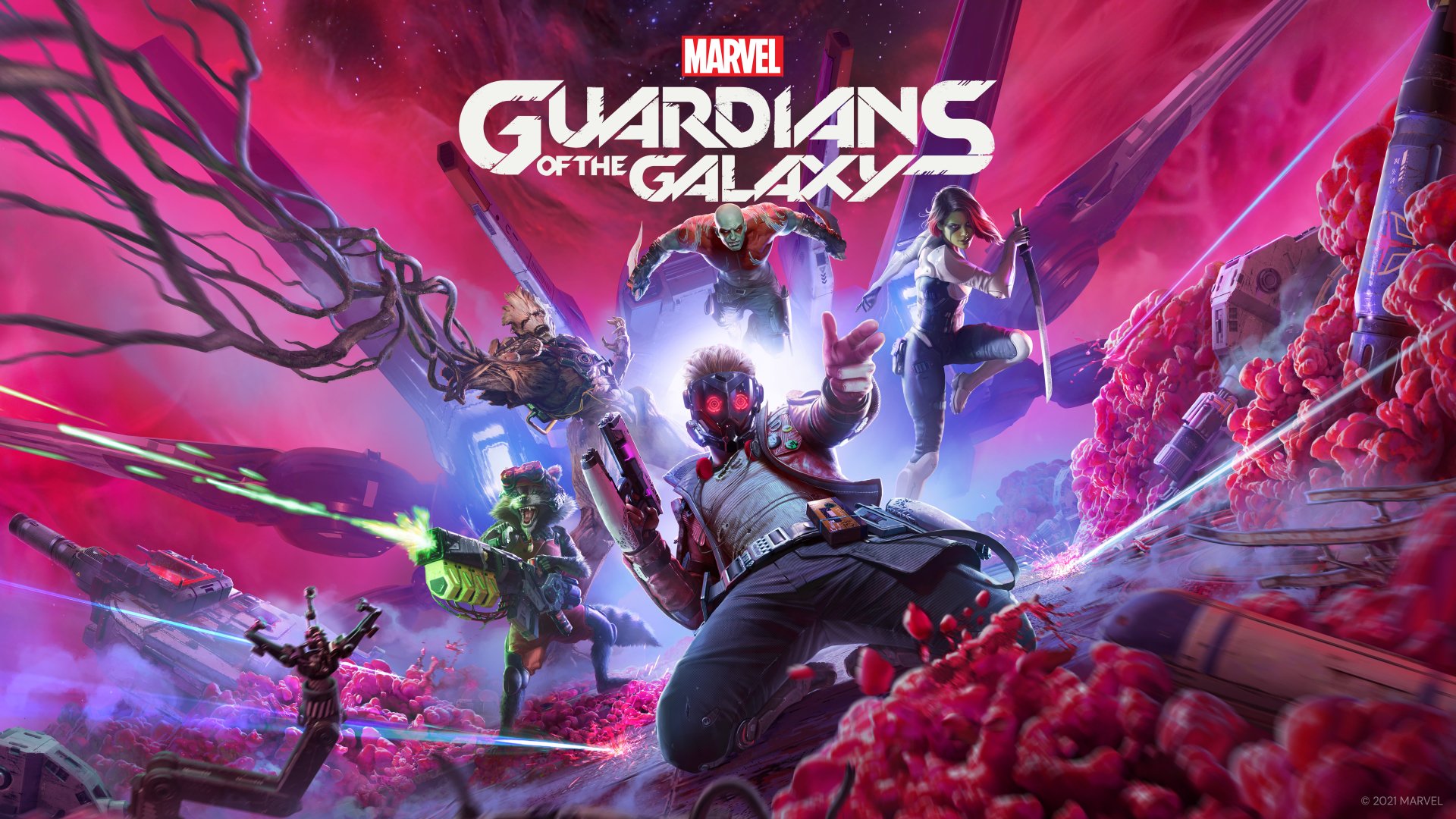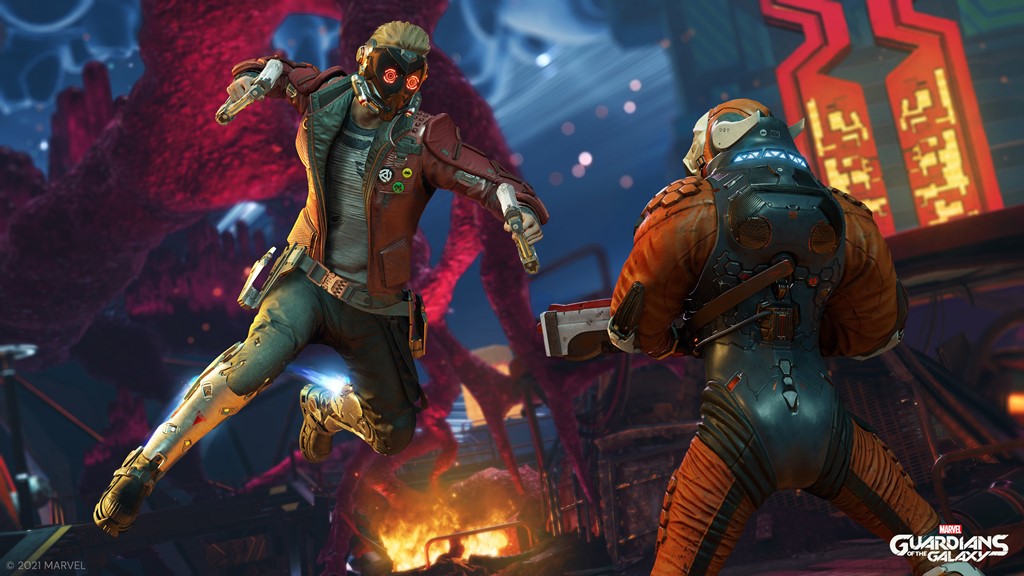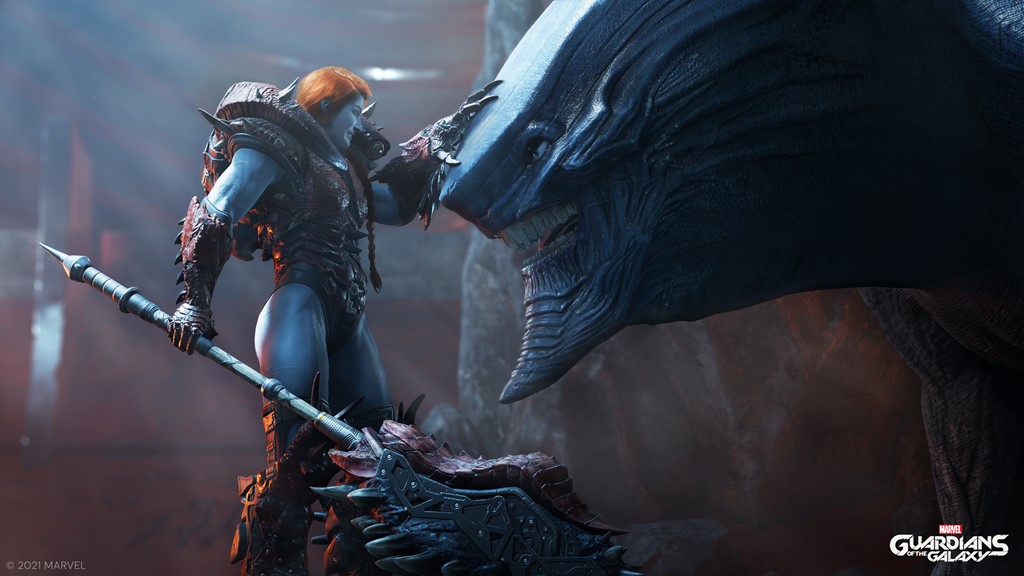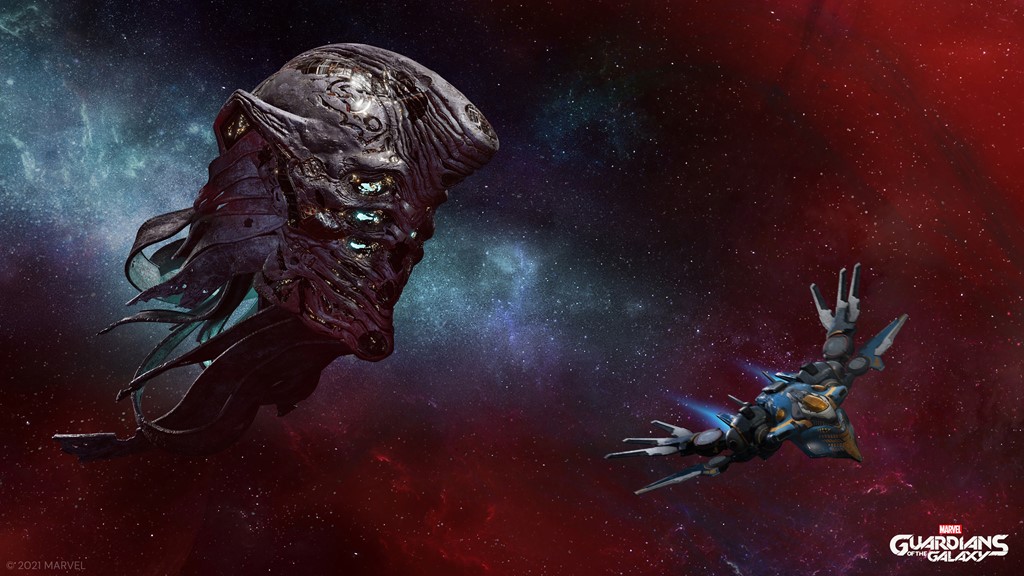Title – Marvel’s Guardians of the Galaxy
Platforms – PS5, PS4, Xbox Series X/S, Xbox One and PC
Release Date – October 26th, 2021
Developer – Eidos Montreal
Publisher – Square Enix
MSRP – $59.99
ESRB – T for Teen
Disclaimer – This product is being reviewed on the PlayStation 5. A review copy was provided by Square Enix for the purpose of this review. This review may also contain spoilers for certain gameplay and story elements. Watch at your own risk, you have been warned. Gaming Instincts is an Amazon Affiliate and does gain financial benefits if you choose to purchase this product on this page.
So here’s the thing… I am not a fan of the Guardians of The Galaxy. There, I said it. I was dragged to the movie back in 2014, the one that everybody freaked out about, and I just did not get it. Maybe I wasn’t ready to get it, or maybe I walked in with a negative attitude in my head, either way, I walked away unfulfilled. Flash forward past a sequel and the superhero stacked team-up that was Infinity War and I am ready to climb aboard the Guardians hype train. Now, walking into this game I expected to enjoy it, not because of the Guardians of The Galaxy but because of my past enjoyment of Eidos Montreal games like the Deus Ex titles. I knew I could expect the game to be enjoyable, but the deeper I ventured into the far reaches of space, the more I found myself loving the journey.
Now, If you are entering Guardians of The Galaxy expecting it to course-correct every issue an Eidos Montreal IP has had, you’re going to have a bad time. The game isn’t perfect and has noticeable issues peppered throughout the lengthy campaign that you are bound to notice, and then probably notice again and again. Though this is true, the team manages to do the most important thing a game developer can do and that is to make their game fun. There was about an hour in there, right at the start, where I thought the game could go either way. The slow build-up was absent of any shooting and got me genuinely worried. Thankfully, when the shooting did start, I knew I was going to be hooked.
The Adventures of Star-Lord
Guardians of The Galaxy should serve both as an easy entry point for players unfamiliar with the characters and as a fresh experience for players that rode to hell and back with them in the MCU or comics. However, in this case, the game draws far more inspiration from the James Gunn Film series which makes sense given the team’s status being firm as a B team in Comics until the films introduced them to a wider audience. Since then the team has seen members come and go, but have usually had the same initial roster. These include the lovable Flora colossus Groot who can only communicate by saying “I am Groot,” though this one sentence can covey a range of thoughts and emotions. The only member of the team that can understand him is his long-time friend and business partner Rocket Racoon, who is a raccoon… thing… and I assume he has a rocket of some kind. Since no team of misfits is complete without a lovable man wanted for serial murder (true story), Drax The Destroyer is an essential addition. You also have the adopted daughter of Thanos, Gamora, though this plot point factored far more into the movies than it will in the original story that the game is set within. Finally, you have the de-facto leader of the team, not to mention the sole playable character Star-Lord A.K.A. Peter Quill.
If you are thinking you heard that last part incorrectly, I promise you that you didn’t. While the other characters appear in the story, share banter, and contribute in combat, the only character the player will control is Star-Lord, and it works out far better than you might think. Make no mistake that while this game is about a group known as the Guardians of The Galaxy, it also serves as a narrative exploration of Peter Quill as a character. Once again we are treated to his backstory within the game, something that has remained relatively unchanged except for the presentation of events, while we also see him bumming around the galaxy trying to make a credit or two. Throughout the story, we are also given several moments where the player can respond to dialog with multiple options that will help endear Peter to the people around him or make them hate his guts, all of which help the player feel connected to the character and his journey. And of course, some of these choices will return in bigger ways down the line, which was one element of the story that both shocked and delighted me. The system had a well-crafted implementation, giving a certain weight to particular decisions.
All of that is put forth before a story that could have been ripped straight out of the comic pages. We start with our group, a newly-formed team of Guardians, as they take on some odd jobs in an attempt to gain some much-needed cash. To accomplish this they do what they do best, bend the rules, and make up excuses to that end. They fly into a quarantined zone to find a beast to sell to a certain collector and this is the first area we get to experience in the story. Of course, since the Gardeners… sorry, I mean Guardians of The Galaxy tend to operate in a gray area, this minor violation of international space law, or whatever it’s called, has far-reaching consequences for the rather long story. For myself, I found I was about 15 hours in and still yet to beat it. While the story is linear in its presentation, it most certainly does not see our heroes follow a straight line. The constant need to run around the galaxy to solve the problems that Star-Lord himself brought on his crew seems, at least from what I know, pretty on-brand for the crew. This works even if there are times you want the game to get on with it.
Oh, and how could we forget the dialog that will keep you entertained throughout the entire story run. The banter works extremely well taking cues from the Square Enix game, Final Fantasy XV. Guardians of the Galaxy is all about the interconnected relationship of the crew, and much of that dialog is presented in-game as opposed to cutscenes. And while the cutscenes not only look great but help to push the character and story arcs forward, the real relationships are presented as characters scream at each other in the heat of battle or have discussions as they wander the field. However, there are some pros and cons to this feature. While it is definitely enjoyable to listen to Gamora and Drax argue, or Rocket spout out condescending comments to Star-Lord, the dialog almost never stops, giving very little downtime to just explore. Star-Lord will also be greeted with similar comments made if you travel off the path looking for collectibles. There were also several moments on the Milano, which is their ship, where I also experienced three conversations at once, making it hard to focus on one and causing the other to become a little glitchy. In the field, multiple conversations rarely happen but they can occur there as well.
The best part though is that, while there are some comments that can repeat, most of the conversations are unique to locations, and situations. For instance, in several battles, long-winded arguments occurred while battling enemies where the characters specifically call out the enemies in question as they attempt to figure out their weaknesses. On other occasions, such as a boss battle against two bounty hunters, Star-Lord and the others shared plenty of enjoyable banter. So much so that I thought I was going to lose the fight thanks to how engaged I was with the dialog. The point is, it’s not just the Guardians that manage to have great banter but the whole galaxy as well. This is where the dialog choices will come into play since Star-Lord has the opportunity to interject his views on several conversations. On the other hand, he does not have to do so, which can also lead to some interesting conversations. If there is one criticism I have for this feature it’s the occasional moments where it gets in its own way. During exploration, when taking on major traversal moments it can pop up, and in these cases player input can be a bit tedious. In some other points of the game, I was given these options right as, say, a floor gave out, causing the dialog to immediately stop. On a whole, conversations and banter have a habit of getting cut off partway as you hit the start of the next exploration segment.
Holding Out For A Hero
As stated above, there is a lot of dialog anchoring the Guardians of The Galaxy Experience. The game would fall heavily with a less enjoyable voice cast than the one assembled, and most of this cast was pulled straight from television to do just that. John Mclaren, primarily a television actor, leads this cast as Star-Lord and thankfully manages to nail his vibe quite well. I imagine it will be hard for fans to see him as their Star-Lord over Chris Pratt, but he definitely deserves praise for his performance. Gamora is voiced by Kimberly-Sue Murray, who manages to give the deadliest woman in the galaxy both an attitude and a vulnerability that insinuates her quieter moments, and her ass-kicking ones. Alex Weiner, who voiced Rocket, had previously worked with Eidos Montreal on the Deus Ex Series and delivers a Rocket that mostly sticks to what fans are used to. While I should not go into specifics here, later moments involving Rocket made Edios’s version of him rewarding, and his voice works memorable. Jason Cavalier voices Drax, the super literal and super strong warrior/serial murderer. Unfortunately, he had to compete with Dave Bautista, who nailed the role in the film and was the one thing I remembered loving in them. He carries the character well but Eidos Montreal didn’t manage to make the character’s facial animations pop in key moments. And finally, we get Robert Montcalm saying “I am Groot” as many times and in as many ways as he can.
As pointed out with Drax, facial animations can be lacking from time to time, a common issue with Eidos Montreal games. While Star-Lord nails most emotions, the other characters tend not to. In the cases of Rocket and Groot this will be less of an issue as they have non-human faces, therefore, are not under the same scrutiny. Drax and Gamora, as well as a litany of supporting characters struggle in this department. Walking into this game as a Deus Ex fan I have learned to live with this issue, but it can be jarring from time to time. That being said, some supporting characters actually manage to have a very engaging emotional range, so it makes this disparity awkward. Beyond that, there is also some movement jankiness to contend with. Several characters make awkward jumps to position themselves for the upcoming cutscene. Similarly, in combat my character often clipped between rocks or a wall, becoming stuck for a few seconds before the game reset me back into combat. Thankfully, the game was so enjoyable, and perhaps because I entered assuming this might be the case, I was able to look past these issues but, at the same time, it’s hard to give them a free pass.
Ever since Guardians of The Galaxy: Awesome Mix Vol. 1 was released alongside the first film in 2014, it’s impossible to discuss the franchise without talking about the soundtrack. Since in the canon Peter was taken to space in the ’80s, or at least the new canon, the game throws a mix of bands of that era into the story. One of the most interesting bands is actually the fictitious band known as Star-Lord, acting as the inspiration for Peter Quills’ alter ego in this universe. Steve Szczepkowski and Yohann Boudreault worked with Eidos Montreal to create this… I assume hair metal band, which has several pretty enjoyable songs to listen to. And on the Milano, the player can cycle through their list of tracks to jam out to. Other artists featured Tears For Fears, Bonnie Tyler, Billy Idol, Pat Benatar, and more. While these songs exist for players to listen to, they are also used consistently in cutscenes to awesome effect. Better yet the characters often have scenes in which they begin singing the song and these moments are always fun. The worst of this licensed music occurs during the powered-up combat segments brought about by huddling up. After doing this, Star-Lord will pop a song on his tape deck to pump up the party. While that might be the intention, and while I love Everbody Wants To Rule The World, it and many other songs have the opposite effect mid-combat. Combat is very fast-paced, with fantastic flow, so many of these songs feel like they take you straight of that mentality, which is a sin considering the heavyweights of ’80s rock they have. On the other hand, White Wedding definitely did it for me.
They Want Me To Keep Blowing Them Up
I was maybe 30 minutes into the game, wandering through the Quarantine Zone, and I was not sure if it was going to click. It was a slow-paced walk along with this very red series of platforms and I just did not know how I felt. At its base, Guardians of The Galaxy is a platformer along with titles such as Ratchet & Clank and Psychonauts 2. Most planets feature large pitfalls surrounding the play area, featuring interconnected walkways most often traversed by jumping over gaps. Occasionally, in order to push forward, the player will need to harness the other Guardians which keeps them relevant as opposed to simple set dressing. Two early examples of this include Groot being able to use his vines to create bridges over drops, and Gamora being able to cut through certain barricades. These actions require player input, which I thought would grow to annoy the hell out of me, but ultimately I found it so well implemented that I never once had an issue with it.
One feature that did annoy the hell out of me was the visor that Star-Lord can use to examine the area. With it, he can find interactable environments that he can command allies to interact with, as well as things that help progress. The biggest issue was that it happens to be on the thumbstick opposite the other thumbstick that lets you use Peter’s combat abilities. Suffice it to say, I constantly put myself in visor mode during the heat of battle. And since exiting turned out to be a finicky experience, I would find myself fighting it instead of the enemies. Second, and this is the big one, while it fits Star-Lord as a character, the visor never seemed needed. Most character interactives are pretty big and obvious, with many simply being called out by allies standing directly next to them. On the other hand, the few times I got stuck on progressing the story, it offered very little help. The only other function it has is finding materials scattered around the world and again, they were kinda hard to miss when standing in a location where the visor would highlight them.
World design doesn’t change much throughout the game, though each world manages to have its own exciting moments to experience while journeying through them. As I stated above, at first the exploration, the slow-paced movement from point A to point B, was going to drain me. Soon, however, it became one of the strongest points of the game. While the levels you traverse will often have similar features, the planets and worlds are diverse. The low-key moments where you can simply ‘take it all in’ will stick with me long after the game. It also manages to keep this diversity and mix the outdoor and indoor setpieces long into the late hours of the game and I loved that. This is something that many a video game has had an issue with, devolving into a formulaic, easy design that bores. In actuality, I don’t think there is a single world or area I didn’t love, though Nowhere stands as one of my favorites.
Combat is designed as an arena-style, extremely frantic, bullet hell in which the player enters a closed-off, finite space to battle. Similar to the rest of the game, you will only control Star-Lord as you fire his two blasters at enemies. Due to him being a shooting character, combat can often occur at a longer range, but the game compensates for this by dealing higher damage numbers the closer you are to an enemy. This creates a certain reward for fighting at a closer range, along with a useful melee attack that can deal some decent damage in addition to the firepower. Combat is continuous and fast as Star-Lord quickly dashes around the arena and dodges attacks. These maneuvers never slow down his steady onslaught of bullets only halting when Star-Lord’s guns need to cool down. The only way you cannot have fun controlling the field, corraling your enemies into kill zones, and unleashing hell on foes that refuse to go down is if you’ve just simply forgotten what fun is.
And the best part is the simplicity of combat, which refuses to add any superfluous mechanics. Each one of your characters, again similar to Final Fantasy XV, has abilities that can be called upon in combat to add on an even bigger whooping. Gamora can jump in for a powerful slash on an enemy, Rocket has a grenade that will mess up all the enemies in an area, and Groot can wrap up his enemies in vines to keep them from moving, which allows your team to take free shots at them. All the Guardians act independently in combat as well, doing attacks, occasionally joining the player in a combo, and even getting knocked down if the enemy forces get overwhelming. Later on, most battles will also have interactable items that you can command your team to utilize without breaking your own flow of combat. Combat that involves sliding across the room on your knees and blasting people behind you. The game also features a leveling system based on instances and not combat. As you progress further each of your teammates will get even more useful abilities to mix up your party’s battles.
Another thing that can help you both in combat and exploring is the workbenches you find along the way. The player will be introduced to this early on when you craft an ability to give your gun cooldown a sweet spot to auto-reload and shoot a powerful attack in the process, helping keep the combat fast-paced even when it should slow down. They will have multiple other abilities to unlock as you progress through the game with many adding a new layer to combat, giving the player an edge. One upgrade causes time to slow down after a perfect dodge allowing for a moment to unload on the enemy of your choice. Narratively, the workbench also grants a decent showcase for the crew’s smartest character, Rocket. Usually, his repairs will be joined with a witty remark to remind players why they love him.
Enemies themselves also manage to range across several worlds, offering many unique fights along the way. While several humanoid enemies will appear in the story, usually in huge waves, the aliens manage to be the most enjoyable enemies to fight. On one of the first planets, you fight a jelly-like enemy, similar to the flans of Final Fantasy. You have to battle them using all your tools to remove their jelly bodies before taking out the core. Another enemy encountered early on is a fast, cat-like alien that will constantly make you dash to safety while blasting away on them. Some of the larger, more powerful enemies will also have moments where you get a button prompt that not only deals good damage but lets your cut a part of their body off as well. These types of enemies will come up a lot, making combat often have these little moments of action.
The worst element of combat, in my opinion, was the huddle-up feature that powers up your party. When a gauge fills up, you can summon a huddle that breaks the flow of combat. The scene, like everything else, has lots of dialog as characters tell you how they are feeling in combat. If they are winning they brag, if not, they lament their enemies. At this point, the player can choose an option to either motivate or demotivate with only Star-Lord buffing in one, while the whole party is buffed for the other. While some choices showcase a clear option, using a phrase that a character said in them, some just look identical to each other. It’s a fun feature at first, but it starts to break the flow of combat too much for a reward that rarely seems worth it. Beyond that, since it opens a new screen, returning makes the player reacclimate to where they were on the field.
Final Verdict
Even though I am a fan of Eidos Montreal, I found myself walking into this optimistic but worried. There are just so many ways you could get an action game about the galaxy’s most talkative heroes wrong. You could make the dialog boring, or just completely intrusive. Instead, it was light, fun, and, best of all, welcomed in almost every situation. The combat, which even I was worried about since you only play as one character, could have been boring, repetitive, and bland. Instead, it is fun and energetic with so many elements that work well together to keep players engaged long into the later hours of the game. Do all the elements work? No, but since so much of it does work, it’s hard to fault the risks that don’t. Does the game have the trademark issues you might expect from an Eidos Montreal game? Yes, it does, and you will definitely notice them. But will they make you want to quit? Definitely not. This game rallies its strengths and manages to deliver not just a great Superhero game, but a great game in general. Definitely don’t miss this adventure of Galactic Proportions.
Stay tuned at Gaming Instincts via Twitter, YouTube, Instagram, and Facebook for more gaming news.







